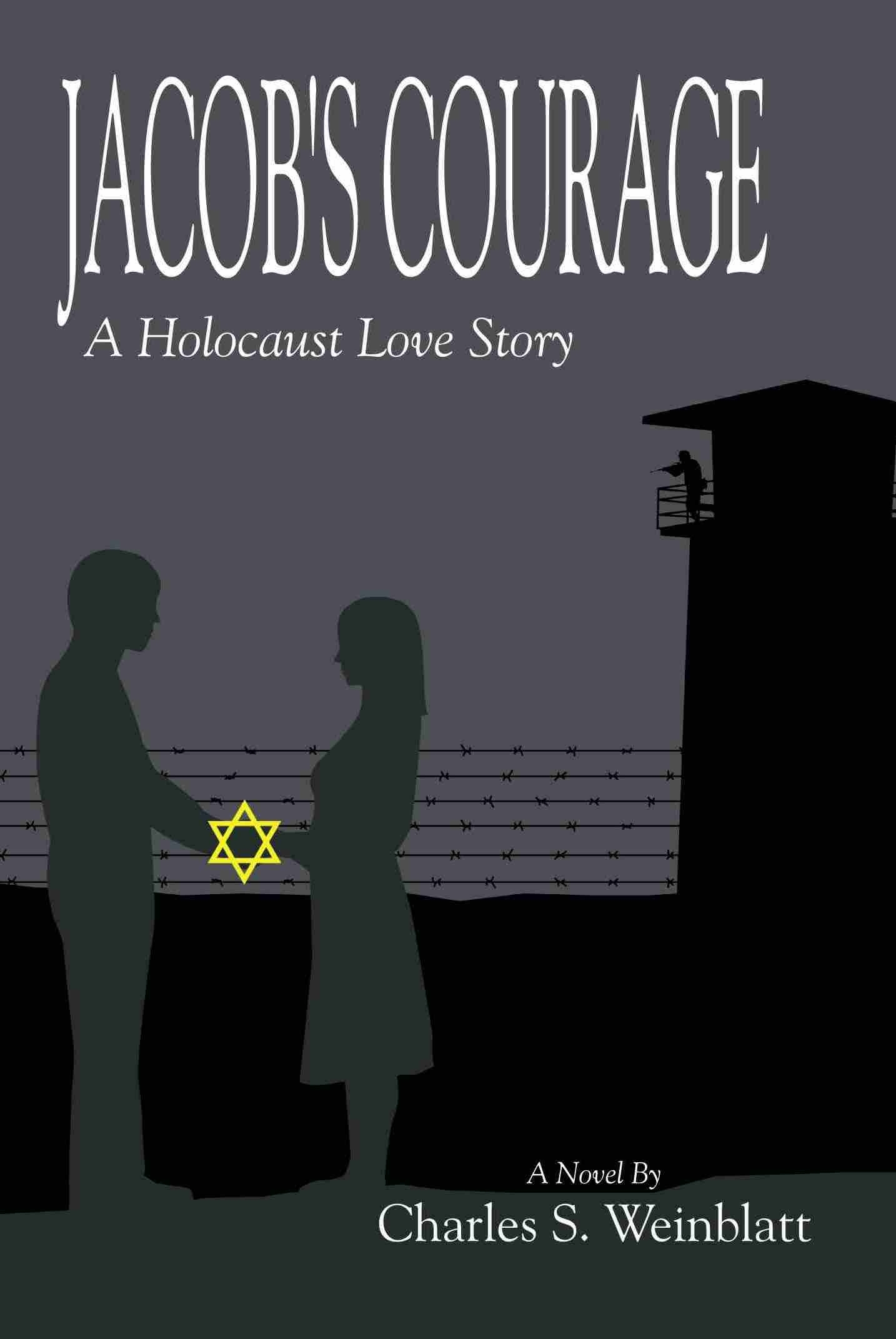Characterization of the Human Spirit
By Charles S. Weinblatt
Published on August 19, 2011

As the author of a Holocaust novel (“Jacob’s Courage”), I appreciate books that offer a frank, emotional examination of morality. Repugnance, despair and darkness exist within human nature. We therefore learn nothing about ourselves if we do not examine this part of our psyche.
The Holocaust also can offer a love story, filled with passion and romance.
During the twelve years of the Shoah, Jewish prisoners of Nazi Germany met, fell in love, became parents, watched their loved ones disappear and fought a desperate battle to remain alive.
They were victims of incomprehensible brutality. Only a few of them survived.
“Jacob’s Courage” explores the complex relationships between humans during the Holocaust. It is a terrifying, unrelenting nightmare and an ecstatic, breathless tale of faith, courage and passion.
There are six million stories about the Holocaust. All of them are unique.
All of them provide texture, complexity and perspective. We are complex beings. There is a great deal more to us than the ubiquitous battleground of good versus evil. We are not one or the other, but a combination of both. We are beautiful and ugly, soothing and terrifying, brutal and caring; we love and we despise.
Deep within the fear and panic of the Holocaust decisions were based upon ethical and emotional veracity. Unlike animals, humans are governed by principles, moral beliefs and sincerity.
We are not clouded by delusions of morality, but governed by them. In “Jacob’s Courage,” my characters explore the human response to terror and immorality, as well as the alluring beauty of passionate young love, along with the driving power of religious devotion.
Our lives are complex – even within the garish midst of the Holocaust. Powerful passion and tender love existed during times of horror and despair. So did a deep commitment to the Jewish relationship between faith and God. These powerful motivators churn within the consciousness of Holocaust victims, creating powerful new behaviors.
Yet, the world is seldom seen in black and white, or shades of gray – even during the Holocaust. In the midst of anguish, beauty exists. Within beauty, despair dwells. Life is experienced as layer upon layer of sensory input, interpreted by our moral compass and defined though our ensuing behavior.
In prior genocides against Jews, there was often an alternative to death – conversion. If Jews would just cease to believe in one God, or if Jews would just renounce their beliefs and accept Christ as the messiah, they could live. Yet, each time that this has occurred in history, the vast majority of Jews refused to capitulate. Those Jews preferred to be burned at the stake, tortured or beheaded, rather than renounce their dedication to the one true God. With Nazi Germany, there was no such choice. Instead of souls to be reclaimed, the German government declared that Jews were similar to rodents, who “infest the true Aryan culture and deserve to be exterminated.”
Nazi Germany did not allow for the possibility that Jews possessed a soul (certainly not one that deserved to be eternal). Sadly, the gentile population of Europe largely did not object to the systematic extermination of their Jewish neighbors. They watched with mildly disinterested eyes as Jews were forced out of their homes and into ghettos. After that, no one seemed to care.
Holocaust survivors lost everything, but perhaps gained something as well. Certainly an honest examination of the Holocaust must reveal torturous brutality and death. Virtually all of the Jewish victims of the Holocaust were guilty of no crime (except to be a Jew). By the end of the war, almost every Holocaust survivor had lost all of their loved ones. Such despair must be worse than psychological death. However, life is not always so simple. And the experience of Jews during the Shoah was not that of cattle going to market. These were not rodents or cows, but families from every location, occupation and lifestyle. They possessed memories, loves, relationships and the heritage of an ancient religion.
Deep within the concentration camps of Nazi Germany, European Jews practiced their religion, observed holidays and commandments, taught their children Hebrew and imparted Jewish values. The entrapped Jews of the Holocaust maintained the facade of their 3,500-year culture, for the sake of their children. Here, in the fetid, crowded walls of concentration camp structures, one can feel hope for the survival of the human spirit, among the ashes of annihilation.
In this age of realism, readers demand multifaceted, often chaotic individuals who possess characteristics both good and bad. They are right. Because that’s the way life is.
If novelists wish to emulate reality, then our characters should become complex humans, with flaws, faults, imperfections and limitations. Some of our villains should possess mercy and empathy, as well. And, no emotion influences us more than guilt.
In “Jacob’s Courage,” my characters were constantly aggravated by guilt. We are forever tortured by our past and guilt is the primary motivator in decisions about our future. We can ignore it or learn from it, but we can never escape from it.
Holocaust victims were faced with the most perfidious forces; deceit, brutality, cruelty, sickness, starvation and the death of loved-ones were the daily companions of concentration camp prisoners. The victims felt guilt for surviving while their loved ones had been murdered. Each of them must have wondered why they deserved to live when those that they worshipped were murdered. Worse yet were the prisoners who assisted the Nazi guards. These “kapos” must have born unwavering guilt.
The “Sonderkommando,” prisoners forced to undress, beat, torture, and kill innocent prisoners must have had the greatest amount of guilt. They were also forced to carry bodies to the furnace. Sometimes, a Jew was forced to feed the dead bodies of his immediate family into the fires of the crematoria. Can you imagine being forced to murder and then destroy the bodies of your loved ones?
In “Jacob’s Courage,” the title character was forced to play in the Auschwitz orchestra as the trains daily disgorged new prisoners, primarily consisting of Jewish families. The ubiquitous innocent queue, waiting their turn to die, constantly occupied his thoughts and dreams. The worst part was watching the Jewish children romp and play, just a few feet away from the gas chamber and their premature death. Many such survivors carried lifelong guilt for surviving, while subconsciously, many must surely have wished for that death with their loved ones.
Novels about this time are by causality dark and precarious. Yet, in the midst of this despair, there was life, love, passion, religious fervor and the excitement known only to children. Even in such hopeless desolation, there was faith, infatuation, romance, excitement and longing for all of the things that humans crave. These characters must embellish the wide range of human attributes and feelings. Such was the complex state of living in a Nazi death camp.
“Jacob’s Courage” describes the Holocaust through the eyes of a normal Jewish family. If we speak only of heroic individuals battling against dark forces, then we dismiss the certainty of our nature. Humans are far more complex than such generic descriptions imply. Not all Jews imprisoned and tortured by Nazi Germany were good. Some became “kapos,” more ruthless than the SS.
Not all Germans were bad. Some Germans were riddled with guilt; and later expressed tender compassion for the imprisoned Jews. Yet, below the surface of brutality, we find the human instinct for life, liberty, love and compassion. We also find the mind of those filled with ruthless barbarity and hostile aggression. This book explores the boundaries of this human expression.
Most of the Jews in Nazi concentration camps comprehended that they would not survive. Yet, within the camps, the Jews constructed synagogues, schools, and orchestras. They had civic leaders, medical clinics, commerce and religious celebrations. Hidden from the SS, Holocaust Jews observed all of the covenants and rituals of their religion, including holidays, marriage ceremonies, burials and circumcisions.
Along the terrifying, dark path to the gas chambers of Nazi-occupied Europe, Jews lived, loved, learned and died. Even in their darkest moments, the Jews of Nazi concentration camps fabricated a “normal” life.
Despite their impending mortality, they recreated a normal world on the inside to protect children from the raging genocide on the outside. Such was the nature and power of their love. They recognized that Judaism couldn’t survive without Jewish children. Unlike concentration camps, the isolation of prisoners in death camps made such religious interaction difficult, if not impossible.
The Holocaust cannot be described without inflicting horror upon the reader. Such books are not for the faint of heart. The human spirit strives for autonomy and freedom. Yet, to search for an understanding of human nature, one must descend into the depths of depravity and terror. We cannot understand humankind without comprehending its wicked flaws.
Deep within the darkest recesses of brutal genocide, the reader will discover a faint flicker of light representing love, passion, desire, hope and reverence. Here is the essence of “Jacob’s Courage” – an examination of morality, love and righteousness, in the midst of the dark whirlwind of malevolence.
The Author

Charles S. Weinblatt was born in Toledo, Ohio in 1952. He is a retired University of Toledo administrator. Weinblatt is the author of “Jacob’s Courage” and “Job Seeking Skills for Students.”
His biography appears in the Marquis Who’s Who in America and Who’s Who in American Education. Weinblatt was a frequent Toledo television news guest, providing business, economic and labor-management insight.
He received the 2004 United Auto Worker’s Douglas Frasier Swift Award and he was awarded a certificate of achievement by Chrysler Corporation.
Weinblatt writes novels, short stories and published articles.
He lives in Ohio with his wife Fran, who is a special education teacher. They have two adult children, Brian and Lauren, who created the cover art for “Jacob’s Courage.”
Please visit: https://jacobscourage.wordpress.com/
Article picture: Book cover of Jacob’s Courage. Tombstone picture by mrganso via Pixabay


